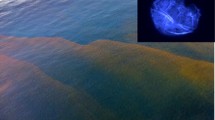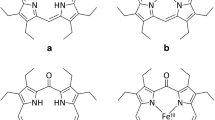Abstract
An iron (Fe)-binding substance (FeBS) was sought for the marine diatom Thalassiosira pseudonana, because the organism is devoid of a gene that encodes the predominant Fe storage protein ferritin. High-performance liquid chromatography–inductively coupled plasma/emission mass spectrometry (HPLC-ICP/MS) analysis of an extract of diatom cells indicated the presence of an FeBS specific to the cells grown in Fe-replete medium. Heat treatment followed by anion-exchange chromatography with monitoring of Fe(III)-dissolving activity was used to isolate the FeBS from the cell extract. Structural analysis using 1H NMR spectrometry demonstrated that the FeBS was composed of citrate. In addition, HPLC-ICP/MS together with ESI–MS demonstrated that the FeBS was likely a triferric tricitrate complex. Although the citrate content of the diatom cells was enhanced according to the Fe nutritional status of the medium, this phenomenon seemed to occur by an indirect mechanism, as a previous report demonstrated a reduced citrate content in T. pseudonana cells grown in Fe-replete medium (Bromke et al. in Plos One doi: 10.1371/journal.pone.0067340, 2013). It is most likely that, based on the extended Redfield ratio 121(C):16(N):1(P):0.0075(Fe), the culture used in the current study may have suffered from nutrient deficiency of a major element, such as nitrogen. Such a situation may occur frequently for this open sea diatom. As windblown dust is a prevailing Fe source for the open oceanic diatom T. pseudonana, a rapid elevation in Fe concentration in the seawater can render the cells nitrogen deficient, causing enhanced citrate synthesis and resulting in the formation of a triferric tricitrate complex as Fe storage machinery.









Similar content being viewed by others
References
Andrews SC (2010) The Ferritin-like superfamily: evolution of the biological iron storeman from a rubrerythrin-like ancestor. Biochim Biophys Acta 1800:691–705
Bagg A, Neilands JB (1987) Molecular mechanism of regulation of siderophore-mediated iron assimilation. Microbiol Rev 51:509–518
Bottger LH, Miller EP, Andresen C, Matzanke BF, Kupper FC, Carrano CJ (2012) Atypical iron storage in marine brown algae: a multidisciplinary study of iron transport and storage in Ectocarpus siliculosus. J Exp Bot 63:5763–5772
Briat JF, Duc C, Ravet K, Gaymard F (2010) Ferritins and iron storage in plants. Biochim Biophys Acta 1800:806–814
Bromke MA, Giavalisco P, Willmitzer L, Hesse H (2013) Metabolic analysis of adaptation to short-term changes in culture conditions of the marine diatom Thalassiosira pseudonana. PLoS One. doi:10.1371/journal.pone.0067340
Eisendle M, Schrettl M, Kragl C, Muller D, Illmer P, Haas H (2006) The intracellular siderophore ferricrocin is involved in iron storage, oxidative-stress resistance, germination, and sexual development in Aspergillus nidulans. Eukaryot Cell 5:1596–1603
Frausto da Silva JJR, Williams RJP (1994) The biological chemistry of the elements. Oxford University Press, New York, pp 319–369
Fukushima T, Sia AK, Allred BE, Nichiporuk R, Zhou ZR, Andersen UN, Raymond KN (2012) Bacillus cereus iron uptake protein fishes out an unstable ferric citrate trimer. PNAS 109:16829–16834
Granum E, Raven JA, Leegood RC (2005) How do marine diatoms fix 10 billion tonnes of inorganic carbon per year? Can J Bot 83:898–908
Guillard RR, Ryther JH (1962) Studies of marine planktonic diatoms.1. Cyclotella nana Hustedt, and Detonula confervacea (cleve) gran. Can J Microbiol 8:229–239
Ho TY, Quigg A, Finkel ZV, Milligan AJ, Wyman K, Falkowski PG, Morel FMM (2003) The elemental composition of some marine phytoplankton. J Phycol 39:1145–1159
Hore PJ (1995) Nuclear magnetic resonance. Oxford University Press, New York, pp 22–43
Hudson RJM, Morel FMM (1989) Distinguishing between extracellular and intracellular iron in marine-phytoplankton. Limnol Oceanogr 34:1113–1120
Kojima I, Iida C (1986) Vapor phase digestion of botanical samples with acids in sealed polyterafluoroethlylene bomb. Anal Sci 2:567–570
Kuma K, Tanaka J, Matsunaga K (1999) Effect of natural and synthetic organic-Fe(III) complexes in an estuarine mixing model on iron uptake and growth of a coastal marine diatom, Chaetoceros sociale. Mar Biol 134:761–769
Li LT, Chen OS, Ward DM, Kaplan J (2001) CCC1 is a transporter that mediates vacuolar iron storage in yeast. J Biol Chem 276:29515–29519
Liu XF, Theil EC (2005) Ferritins: dynamic management of biological iron and oxygen chemistry. Acc Chem Res 38:167–175
Maldonado MT, Price NM (1996) Influence of N substrate on Fe requirements of marine centric diatoms. Mar Ecol Prog Ser 141:161–172
Marchetti A, Sherry ND, Kiyosawa H, Tsuda A, Harrison PJ (2006) Phytoplankton processes during a mesoscale iron enrichment in the NE subarctic Pacific: part I—biomass and assemblage. Deep Sea Res Part II 53:2095–2113
Marchetti A, Parker MS, Moccia LP, Lin EO, Arrieta AL, Ribalet F, Murphy MEP, Maldonado MT, Armbrust EV (2009) Ferritin is used for iron storage in bloom-forming marine pennate diatoms. Nature 457:467–470
Matzanke BF, Bill E, Trautwein AX, Winkelmann G (1987) Role of siderophores in iron storage in spores of neurospora-crassa and aspergillus-ochraceus. J Bacteriol 169:5873–5876
Mendez J, Guieu C, Adkins J (2010) Atmospheric input of manganese and iron to the ocean: seawater dissolution experiments with Saharan and North American dusts. Mar Chem 120:34–43
Nuester J, Vogt S, Twining BS (2012) Localization of iron within centric diatoms of the genus Thalassiosira. J Phycol 48:626–634
Rellan-Alvarez R, Giner-Martinez-Sierra J, Orduna J, Orera I, Rodriguez-Castrillon JA, Garcia-Alonso JI, Abadia J, Alvarez-Fernandez A (2010) Identification of a tri-iron(III), tri-citrate complex in the xylem sap of iron-deficient tomato resupplied with iron: new insights into plant iron long-distance transport. Plant Cell Physiol 51:91–102
Roschzttardtz H, Conejero G, Curie C, Mari S (2009) Identification of the endodermal vacuole as the iron storage compartment in the Arabidopsis embryo. Plant Physiol 151:1329–1338
Valko M, Morris H, Cronin MTD (2005) Metals, toxicity and oxidative stress. Curr Med Chem 12:1161–1208
Wells ML, Price NM, Bruland KW (1995) Iron chemistry in seawater and its relationship to phytoplankton. Mar Chem 48:157–182
Winkelmann G (1992) Structures and functions of fungal siderophores containing hydroxamate and complexone type iron-binding ligands. Mycol Res 96:529–534
Yue WW, Grizot S, Buchanan SK (2003) Structural evidence for iron-free citrate and ferric citrate binding to the TonB-dependent outer membrane transporter FecA. J Mol Biol 332:353–368
Acknowledgments
This study was supported in part by the ISIJ Innovative Program for Advanced Technology.
Author information
Authors and Affiliations
Corresponding author
Additional information
Responsible Editor: K. Yin.
Reviewed Undisclosed experts.
Electronic supplementary material
Below is the link to the electronic supplementary material.
Rights and permissions
About this article
Cite this article
Imura, Y., Sasai, K., Inui, Sy. et al. Citrate as a possible iron-pooling substance in the marine diatom Thalassiosira pseudonana . Mar Biol 163, 138 (2016). https://doi.org/10.1007/s00227-016-2907-x
Received:
Accepted:
Published:
DOI: https://doi.org/10.1007/s00227-016-2907-x




